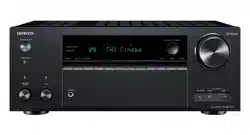Documents: Go to download!
User Manual
- User Manual - (English)
- Specification Sheet - (English)
- Spec Sheet (web) - (English)

Instruction Manual AV RECEIVER
Part Names
Front Panel
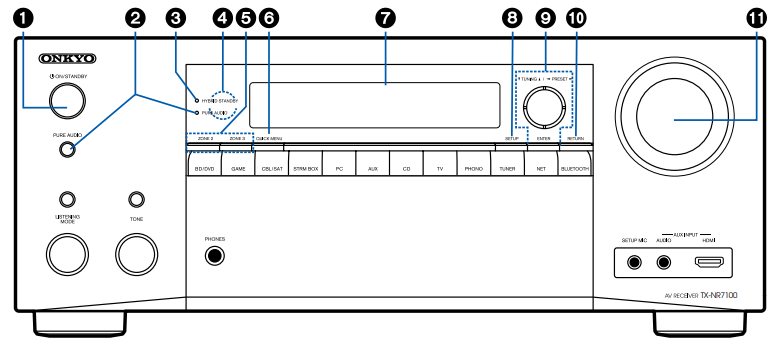
 ON/STANDBY button
ON/STANDBY button- PURE AUDIO button/indicator: Switches to the Pure Audio mode. The indicator lights when the mode is on. ( →p179)
- HYBRID STANDBY indicator: Lights up when any of the following functions is working or enabled in standby state of this unit. When this indicator is lighting, the power consumption in standby state increases, however, the increase in power consumption is minimized by entering the HYBRID STANDBY mode where only the essential circuits operate.
- HDMI CEC ( →p127)
- HDMI Standby Through ( →p127)
- USB Power Out at Standby ( →p134)
- Network Standby ( →p134)
- Bluetooth Wakeup ( →p135)
- Remote control sensor: Receives signals from the remote controller.
- The reception range of the remote controller is within a distance of approx. 16´/5 m, and an angle of 20° in vertical direction and 30° to right and left.
- ZONE 2/ZONE 3 buttons: Controls the multizone function. ( →p92)
- QUICK MENU button: Pressing this button during playback can make settings such as "HDMI" and "Audio" quickly on the TV screen while playing. ( →p76)
- Display ( →p13)
- SETUP button: You can display advanced setting items on the TV and the display to have a more enjoyable experience with this unit. p108)
- Cursor buttons (
 ) and ENTER button: Select an item with the cursors, and press ENTER to confirm your selection. When using TUNER, use them to tune in to stations. p68)
) and ENTER button: Select an item with the cursors, and press ENTER to confirm your selection. When using TUNER, use them to tune in to stations. p68) - RETURN button: Returns the display to the previous state while setting.
- MASTER VOLUME
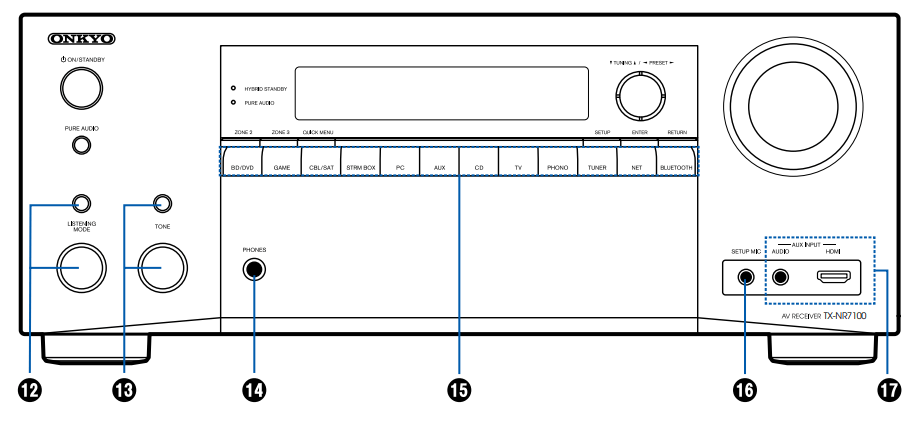
- LISTENING MODE button/dial: Press the LISTENING MODE button (above) to select a category from "Movie/TV", "Music" and "Game", and then turn the LISTENING MODE dial (below) to change the listening mode ( →p74).
- TONE button/dial: Adjusts the sound quality. Press the TONE button (above) to select an item to adjust from "Bass", "Vocal" and "Treble", and turn the TONE dial (below) to adjust.
- PHONES jack: Connect headphones with a standard plug (ø1/4″/6.3 mm).
- Input selector buttons: Switches the input to be played.
- SETUP MIC jack: Connect the supplied speaker setup microphone. ( →p144, p146)
- AUX INPUT AUDIO/HDMI jack: Connect a video camera, etc. using a stereo mini plug cable (ø1/8″/3.5 mm) or HDMI cable. ( →p55)
Display
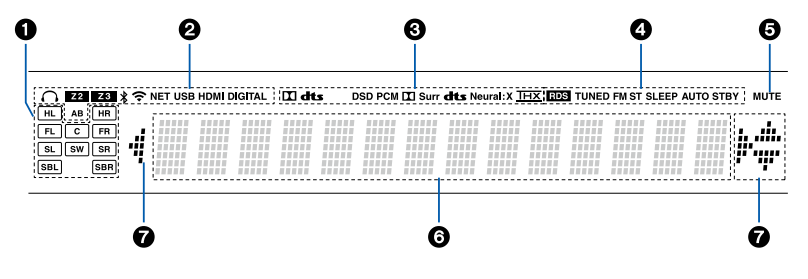
1.Speaker/Channel display: Displays the output channel that corresponds to the selected listening mode.
2.Lights in the following conditions.
 Headphones are connected.
Headphones are connected.
Z2/Z3: ZONE 2/ZONE 3 is on.
 Connected by BLUETOOTH.
Connected by BLUETOOTH.
 Connected by Wi-Fi.
Connected by Wi-Fi.
NET: Lights when connected to the network with the "NET" input selector. It will blink if incorrectly connected to the network.
USB: Lights when the "NET" input selector is selected, a USB device is connected and the USB input is selected. It will blink if the USB device is not properly connected.
HDMI: HDMI signals are input and the HDMI input is selected.
DIGITAL: Digital signals are input and the digital input is selected.
A: Audio is output only to ZONE A.
B: Audio is output only to ZONE B.
AB: Audio is output to both ZONE A and ZONE
3. Lights according to the type of input digital audio signal and the listening mode.
4. Lights in the following conditions.
RDS (European, Australian and Asian models): Receiving RDS broadcasting.
TUNED: Receiving DAB (European models)/AM (North American, Australian and Asian models)/ FM radio
FM ST: Receiving FM stereo.
SLEEP: Sleep timer is set.
AUTO STBY: Auto Standby is set. ( →p134)
5. Blinks when muting is on.
6. Displays various information of the input signals.
- DialogNorm: X dB" ("X" is a numerical value) may be displayed when software recorded in
- Dolby lineage or DTS lineage audio formats is played. For example, if "DialogNorm: +4 dB" is displayed, the source being played is recorded with 4 dB plus the THX standard level. If you play it with the THX standard level, lower the volume by 4 dB.
7. Cursors (  /
/ /
/ /
/ ): These may light when performing operations while “NET” is selected with the input selector.
): These may light when performing operations while “NET” is selected with the input selector.  /
/ light when there are multiple folders or files that are available to be selected.
light when there are multiple folders or files that are available to be selected.  /
/ light when text information does not fit with the range provided by “
light when text information does not fit with the range provided by “ ”.
”.
Rear Panel

- DIGITAL IN OPTICAL/COAXIAL jacks: Input TV or AV component digital audio signals with a digital optical cable or digital coaxial cable.
- TUNER AM/FM terminal (North American, Australian and Asian models): Connect the supplied antennas.
TUNER DAB/FM terminal (European models): Connect the supplied antennas.
- COMPONENT VIDEO IN jacks: Input AV component video signals with a component video cable. (Compatible only with 480i or 576i resolution.)
VIDEO IN jacks: Input AV component video signals with an analog video cable. - Wireless antenna: Used for WI-Fi connection or when using a BLUETOOTH enabled device. Adjust the angles according to the connection status.
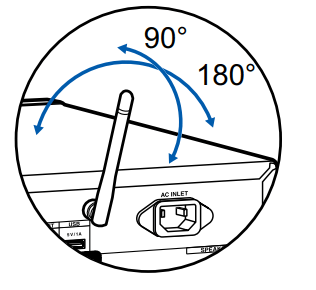
- HDMI OUT jacks: Transmit video signals and audio signals with an HDMI cable connected to a monitor such as a TV or projector.
- RS-232 port: Connect a home control system equipped with an RS-232C port. For installing a home control system, contact the specialized stores.
- HDMI IN jacks: Transmit video signals and audio signals with an HDMI cable connected to an AV component.
- ETHERNET port: Connect to the network with an Ethernet cable.
- USB port: Connect a USB storage device to play music files ( →p98). You can also supply power (5 V/1 A) to USB devices with a USB cable.
- AC INLET: Connect the supplied power cord.

- GND terminal: Connect the ground wire of the turntable.
- AUDIO IN jacks: Input AV component audio signals with an analog audio cable.
- 12V TRIGGER OUT jack: Connect a device equipped with a 12V trigger input jack to enable power link operation between the device and this unit. ( →p61)
- IR IN port: Connect a remote control receiver unit. ( →p60)
- PRE OUT FRONT jacks(European, Australian and Asian models): Connect to a power amplifier. ( →p46)

- SPEAKERS terminals: Connect speakers with speaker cables. (North American models support banana plugs. Use a plug 4 mm in diameter. Y plug connection is not supported)
- SUBWOOFER PRE OUT jacks: Connect a powered subwoofer with a subwoofer cable. Up to two powered subwoofers can be connected. The same signal is output from each SUBWOOFER PRE OUT jack.
- ZONE 2 LINE OUT jacks: Output audio signals with an analog audio cable connected to an integrated amplifier in a separate room (ZONE 2).
ZONE B LINE OUT jacks: Simultaneously output the same audio source as the speakers (ZONE A) connected to this unit by connecting this unit to wireless headphones, wireless speaker transmitter, etc., using an analog audio cable.
Remote Controller

 ON/STANDBY button
ON/STANDBY button- Input selector buttons: Switches the input to be played.
- Play buttons: Used for playback operations for the Music Server ( →p100) or USB device p98). Also, switching to "CEC MODE" with "19. MODE button" allows you to operate an HDMI CEC function-enabled AV component. Some devices may not be operated.)
- Q (QUICK MENU) button: Pressing this button during playback allows you to make settings such as "HDMI" and "Audio" quickly on the TV screen while playing. ( →p76)
- Cursor buttons and ENTER button: Select an item with the cursors, and press ENTER to confirm your selection. Pressing / button allows you to switch the screen when a music folder list or file list is not displayed on one screen on the TV.
 button: Displays advanced setting items on the TV or the display to have a more enjoyable experience with this unit. ( →p108)
button: Displays advanced setting items on the TV or the display to have a more enjoyable experience with this unit. ( →p108)- SLEEP button: You can allow the unit to enter standby automatically when the specified time has elapsed. Select the time from "30 min", min", "90 min" and "Off". When you do not want to turn the unit to standby automatically, select "Off". You can also set this by pressing
 button and selecting "5. Hardware" - "Power Management" - "Sleep Timer" ( →p134) on the Setup menu.
button and selecting "5. Hardware" - "Power Management" - "Sleep Timer" ( →p134) on the Setup menu. - HDMI MAIN/SUB button: Select the HDMI OUT jack to output video signals from "MAIN", "SUB", and "MAIN+SUB".
- i button: Switches the information on the display and is used to operate RDS ( →p69).
Also, when the "BLUETOOTH" input selector is selected, pressing and holding this button for 5 seconds or more will switch to the pairing mode.  button: Returns the display to the previous state while setting.
button: Returns the display to the previous state while setting. MUTE button: Temporarily mutes audio. Press the button again to cancel muting.
MUTE button: Temporarily mutes audio. Press the button again to cancel muting.
- TONE buttons: Adjusts the sound quality. Press "TREBLE", "BASS", or "VOCAL" to select what you want to adjust, then adjust with + and -. TREBLE/BASS button: You can adjust the sound quality of the speakers.
- Press TREBLE or BASS to select the content to adjust.
TREBLE: Enhances or moderates the hightone range of the speakers.
BASS: Enhances or moderates the low-tone range of the speakers. - Press + or - to adjust.
VOCAL button: Emphasizes movie dialogues and music vocals to listen to them more easily. It is effective to movie lines in particular. Also, it exerts the effect even if the center speaker is not used. Select a desired level from "1" (low) to "5" high). - Press VOCAL.
- Press + or - to adjust. Depending on the input source or listening mode setting, selection is not possible, or the desired effect may not be achieved.
- Press TREBLE or BASS to select the content to adjust.
- LISTENING MODE buttons: Selects a listening mode ( →p74, p169).
- DIMMER button: Switches the brightness of the display with three levels. It cannot be turned off completely.
- ZONE 2/ZONE 3 SHIFT button: Used to control the multi-zone function ( →p92).
- VOLUME buttons
- CLEAR button: Deletes all characters you have entered when entering text on the TV screen.
- MEMORY button: Used to register DAB (European models)/AM (North American, Australian and Asian models)/FM radio stations. ( →p73)
- MODE button: Switches between automatic tuning and manual tuning for AM (North American, Australian and Asian models)/FM stations ( →p68), and allows you to select the order for displaying DAB stations (European models) ( →p72). Also, when an HDMI CEC function-enabled AV component is connected to this unit, you can switch "3. Play buttons" between "CEC MODE" and "RCV MODE" (normal mode).
Inputting Characters
You can input characters or symbols on the keyboard displayed on the TV screen such as when inputting a password for Wi-Fi Setup ( →p129) or naming a preset radio station ( →p125).
- Select a character or symbol with the cursors
 on the remote controller and press the ENTER button.
on the remote controller and press the ENTER button. - When saving characters after input, select "OK" and press the ENTER button.
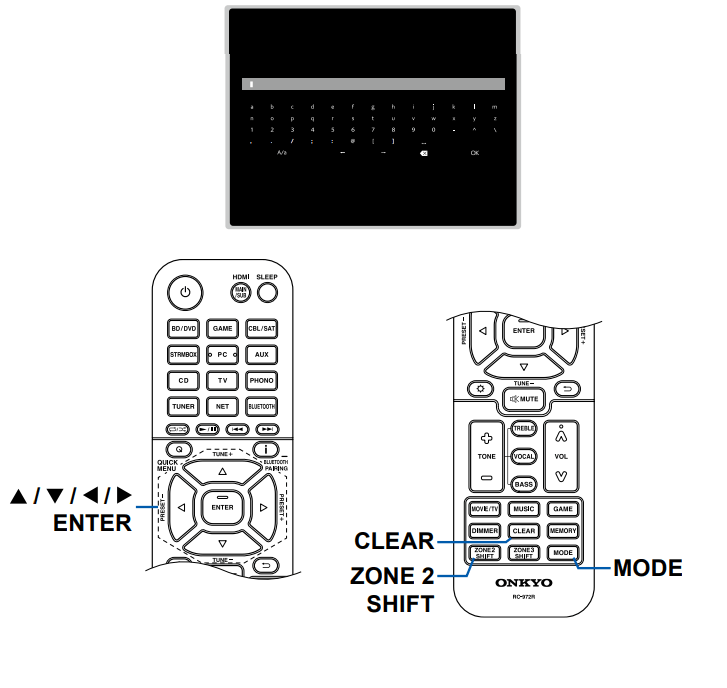
- Select "A/a" to switch between upper and lower cases. (Can also be switched with the MODE button on the remote controller.)
- To enter a space, select "
 ".
". - To delete a character on the left of the cursor, select "
 ".
". - To delete all the input characters, press the CLEAR button on the remote control.
- On the ZONE 2 playback screen, operate the remote controller while pressing and holding the ZONE 2 SHIFT button. To delete all the input characters, only press the CLEAR button without pressing the ZONE 2 SHIFT button.
Connections
Push HDMI cables straight in and all the way. You can damage the terminals if you try to insert at an angle.
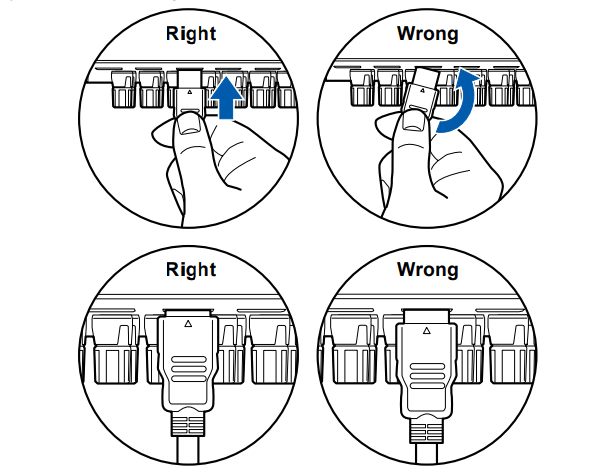
- Hold the terminal housing on the HDMI cable when unplugging. Pulling on the cable may lead to damaged cabling.
(Note) Placement of cables
Putting a load on HDMI cables can lead to poor operational performance. Place the cables so there is no load put on them.

- When 4K high-quality video (4K 60Hz, 4K HDR, etc.) is to be played, use
- Premium High Speed HDMI Cable or Premium High Speed HDMI Cable with Ethernet that have the "PREMIUM Certified Cable" label attached to the packaging.
When 8K high-quality video (8K 60Hz, etc.) is to be played, use ULTRA High
Speed HDMI Cable that has the "ULTRA HIGH SPEED" label attached to the packaging.
Connecting the TV
By connecting a TV to this unit, you can show the video from AV devices connected to this unit on the TV and also play the sound from the TV through this unit.
To ARC/eARC TV
 If the TV supports the ARC (Audio Return Channel) function(*), use only the HDMI cable to connect with the TV. Use the ARC-compatible HDMI IN jack of the TV for connection. You connect the HDMI cable to the HDMI OUT MAIN jack labeled "ARC" on the receiver side.
If the TV supports the ARC (Audio Return Channel) function(*), use only the HDMI cable to connect with the TV. Use the ARC-compatible HDMI IN jack of the TV for connection. You connect the HDMI cable to the HDMI OUT MAIN jack labeled "ARC" on the receiver side.
- When a TV compatible with the eARC function is connected, use an HDMI cable that supports Ethernet.
To Non-ARC TV
If the TV does not support the ARC (Audio Return Channel) function(*), connect an HDMI cable and digital optical cable. If the TV does not have a DIGITAL OPTICAL OUT jack, you can use an analog audio cable to connect with the AUDIO IN TV jack.
- If you use a cable set-top box, etc. connected to the input jack of this unit to watch TV (without using a TV’s built-in tuner), connection with a digital optical cable or analog audio cable is not required.
 Setup
Setup
- When not using the ARC function, press on the remote controller, then set "5.Hardware" - "HDMI" - "Audio Return Channel (eARC supported)" p128) to "Off".
(*)The ARC function and eARC function transmit the audio signals of the TV via an HDMI cable, and plays the audio of the TV on this unit. To check if the TV supports the ARC function and eARC function, refer to the instruction manual of the TV, etc.
ARC/eARC compatible audio formats ( →p185)
- Settings are required when 4K or 8K high-quality video is to be played. Refer to "HDMI 4K/8K Signal Format" ( →p111) for information on the settings. Also, use an HDMI cable that supports 4K or 8K video.
Connecting Antennas
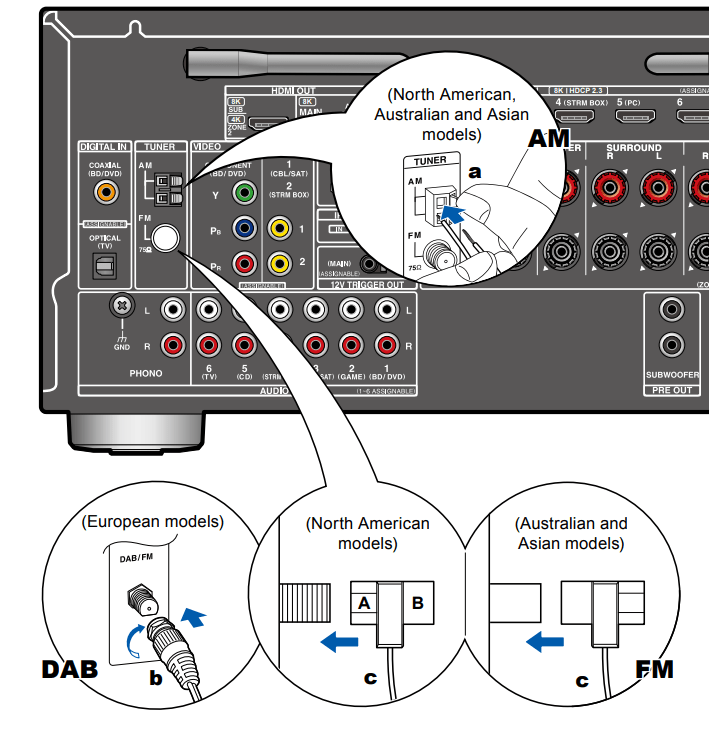
a AM loop antenna, b DAB/FM antenna, c Indoor FM antenna
North American, Australian and Asian models
Connect the antenna to this unit, and set up the antenna at the best position for listening while receiving radio signals. Attach the indoor FM antenna to the wall using push pins or adhesive tape.

European models
Make sure the plug is pushed in all the way, then fix in place by turning the nut to the right. Use a tack or similar to fix the antenna to a wall.

Network Connection
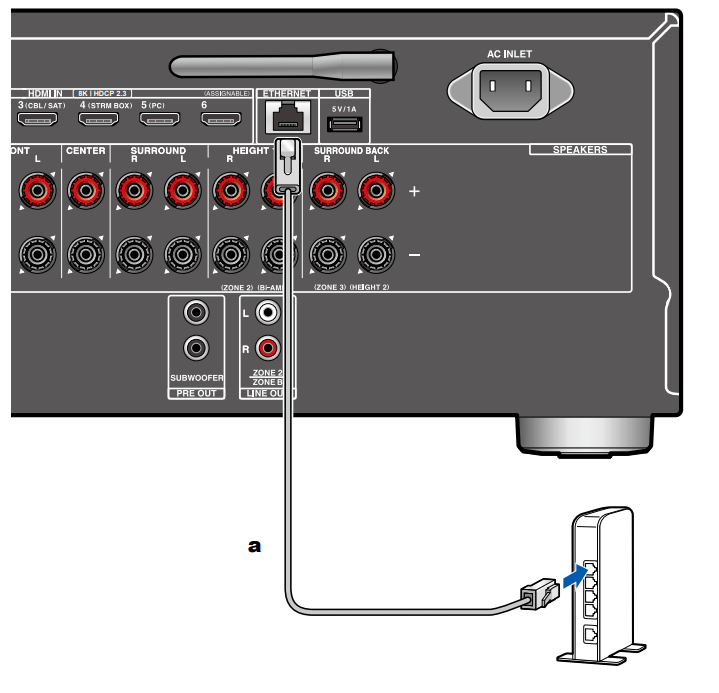
a Ethernet cable
This unit can be connected to the network using a wired LAN or Wi-Fi (wireless LAN). You can enjoy network functions such as Internet radio by network connection. If connection is made by the wired LAN, connect the router and the ETHERNET jack with the Ethernet cable as shown in the illustration. To connect by Wi-Fi, select your desired setting method in "Network Connection" ( →p142) of Initial Setup, and then follow the on-screen instructions. To configure the setting on the Setup menu after the completion of Initial Setup, press the button on the remote controller, and select "5. Hardware" - "Network" to make the setting ( →p129). For the Wi-Fi connection, stand the wireless antenna for use.
Connecting External Control Devices
IR IN port
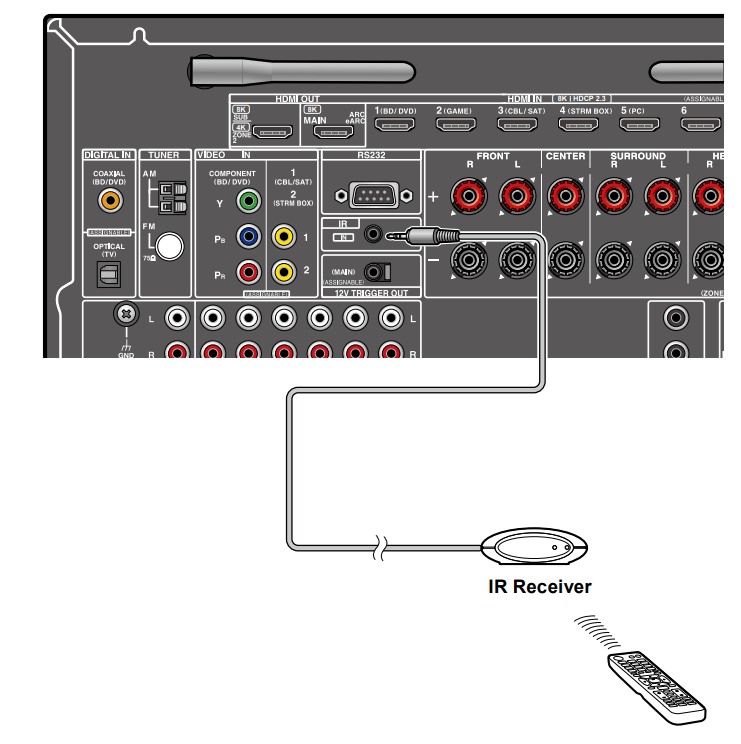
When connecting a remote control receiver unit consisting of an IR Receiver, etc. to this unit, operation using the remote controller is possible even if the remote control signal is difficult to reach (due to installation in the cabinet, etc.). You can also operate the unit using the remote controller from a separate room such as ZONE 2. For installing a remote control receiver unit, contact the specialized stores.
- For the type of cable required for connection, refer to the operation manual, etc. of the remote control receiver unit.
12V TRIGGER OUT jack
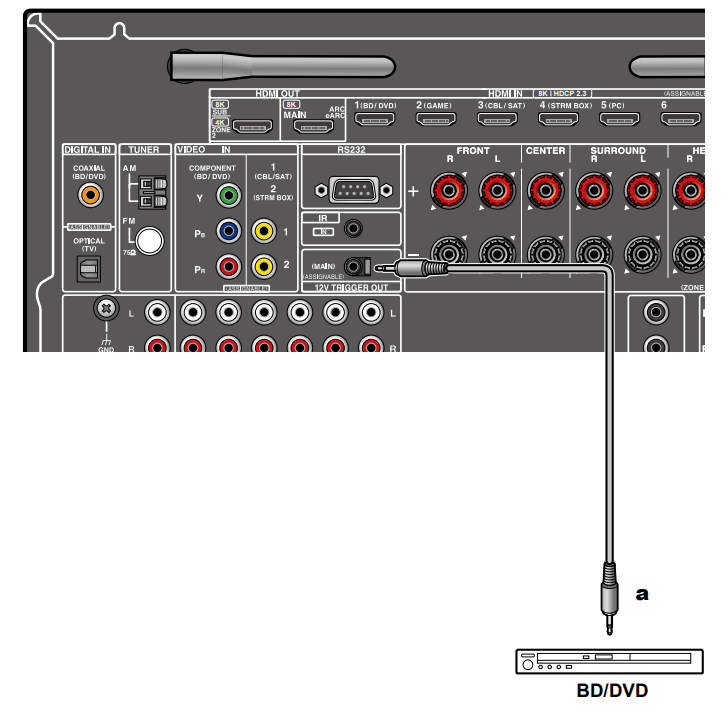
a Monaural mini plug cable (ø1/8″/3.5 mm)
When connecting a device equipped with a TRIGGER IN jack such as a BD/ DVD player to this unit, the device can be turned on or set to standby by interlocking the operation on this unit. When any input is selected, this unit outputs a maximum of 12 V/100 mA control signal from the 12V TRIGGER OUT jack, and controls the power link operation of the external device.
- For connection, use a monaural mini plug cable (ø1/8″/3.5 mm) without resistance. Do not use a stereo mini plug cable.
 Setup
Setup
Settings are required to output control signals from the 12 V TRIGGER OUT jack. Press the button on the remote controller, select the input desired for "5.Hardware" - "12V Trigger" ( →p135), and set the output destination for the control signal.
Basic Operations
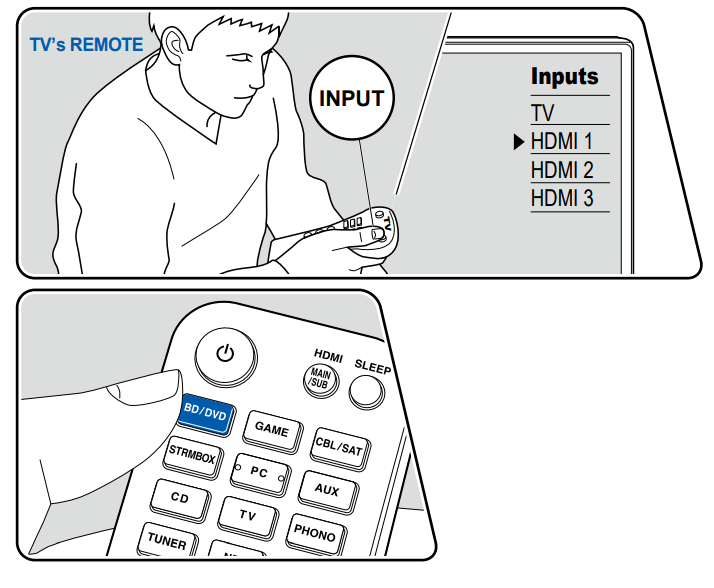
Perform the following procedure when this unit is on.
- Switch the input on the TV to the input connected to the unit.
- Press the input selector whose name is the same as that of the jack to which the player is connected.
For example, press BD/DVD to play the player connected to the BD/DVD jack.
Press TV to listen to the sound of the TV. Also, to play a device connected to the AUX INPUT AUDIO/HDMI jack on the front panel, press AUX.- When the CEC link function works, the input switches automatically when a CEC compliant TV or player is connected to this unit using HDMI connection.
- Start play on the AV component

BLUETOOTH® Playback
You can wirelessly play music on a smartphone or other BLUETOOTH wireless technology enabled device through the speakers connected to this unit. It is also possible to transmit the audio from this unit to BLUETOOTH enabled headphones, wireless speakers, etc.
Playing audio from BLUETOOTH wireless technology enabled devices with this unit
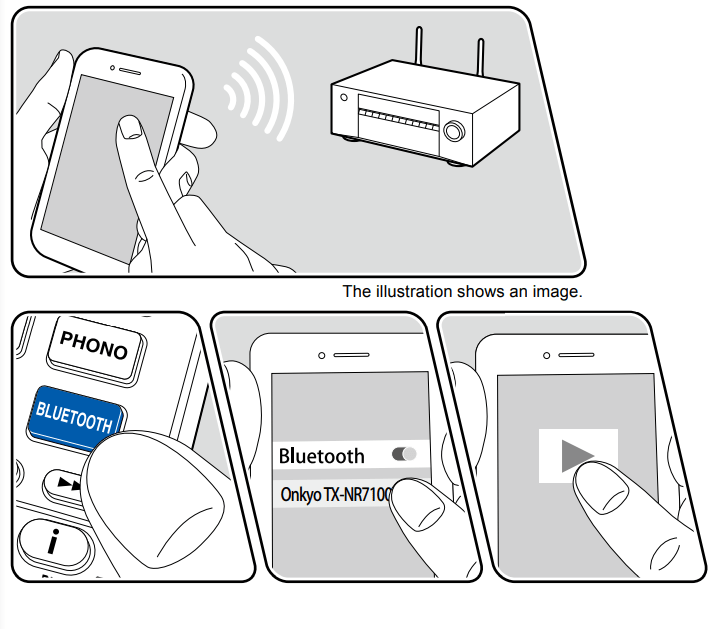
Perform the following procedure when this unit is on.
Pairing
- When you press the BLUETOOTH button, "Now Pairing..." appears on the display, and the pairing mode is enabled.

- Enable (turn on) the BLUETOOTH function of the BLUETOOTH enabled device, and then select this unit from among the devices displayed. If a password is requested, enter "0000".
- This unit is displayed as "Onkyo TX-NR7100 XXXXXX". This display can be changed using the Friendly Name function ( →p130) or Onkyo Controller ( →p147) (available on iOS or Android™).
- To connect another BLUETOOTH enabled device, press and hold the button at least 5 seconds, and then perform step 2. This unit can store the pairing information of up to 8 paired devices.
- The coverage area is approx. 48´/15 m. Note that connection is not always guaranteed with all BLUETOOTH enabled devices.
Playing Back
- Perform the connection procedure on the BLUETOOTH enabled device.
- Playing the music file.
The input on this unit automatically switches to "BLUETOOTH".
Turn up the volume of the BLUETOOTH enabled device to an appropriate level.
- Due to the characteristics of BLUETOOTH wireless technology, the sound produced on this unit may slightly be behind the sound played on the BLUETOOTH enabled device.
Transmitting audio from this unit to BLUETOOTH wireless technology enabled devices

Pairing
- Press the input selector you want to play.
- Select a source other than "BLUETOOTH". This function does not work if you select "BLUETOOTH".
- Press the
 button on the remote controller, select "5. Hardware" - "Bluetooth" - "Bluetooth Transmitter", and press the ENTER button.
button on the remote controller, select "5. Hardware" - "Bluetooth" - "Bluetooth Transmitter", and press the ENTER button. - Select either "On (Tx)" or "On (Main + Tx)" in "Bluetooth Transmitter".
- If you select "On (Tx)", playback is from the Bluetooth wireless technology enabled device only, and if you select "On (Main + Tx)", playback is from both the Bluetooth wireless technology enabled device and the main unit.
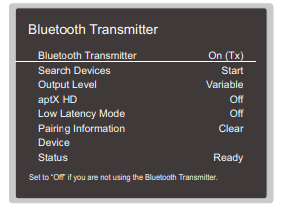
- If you select "On (Tx)", playback is from the Bluetooth wireless technology enabled device only, and if you select "On (Main + Tx)", playback is from both the Bluetooth wireless technology enabled device and the main unit.
- In "Search Devices", press ENTER.
- The search starts for BLUETOOTH wireless technology enabled devices that are able to receive, then a list of relevant devices is displayed.
- Select the device you want to output the audio from, and when you press ENTER the message "Now Pairing…" is displayed and the two are paired.
- Depending on the BLUETOOTH wireless technology enabled device, you may need to pair manually. If the device name does not appear in the list, check the settings of the BLUETOOTH wireless technology enabled device
Playing Back
- Do the play operations on the AV component connected to this unit. Do the play operations on this unit when the input is TUNER or NET.
- If "Variable" has been selected for the "Output Level", the volume can be adjusted on this unit. Adjust to a suitable volume on the connected Bluetooth wireless technology enabled device beforehand. If "Fixed" is selected, adjust the volume on the Bluetooth wireless technology enabled device.
- You cannot transmit audio to multiple BLUETOOTH wireless technology enabled devices from this unit.
- The coverage area is approx. 48´/15 m. Note that connection is not always guaranteed with all BLUETOOTH enabled devices.
- When "Bluetooth Transmitter" is "On (Tx)" or "On (Main + Tx)" and in the following cases, when this unit detects a paired Bluetooth wireless technology enabled device, it will automatically reconnect with that device.
- When the power is turned on again after the unit is switched to standby
- While other than "BLUETOOTH" is selected
- When the "NET" input is selected and there is audio output from a network service/content (some services excluded)
When not using this function, select "Off" in "Bluetooth Transmitter" to cancel the connection. Also disconnect on the receiving device (if disconnection is possible on the receiving device).
- Audio cannot be output from a BLUETOOTH wireless technology enabled device in the following cases:
- When the audio file is DSD format
- When playing audio from one of the following network services: cChromecast built-in, Amazon Alexa, AirPlay, DTS Play-Fi
- Sound quality adjustments and listening modes of this unit cannot be applied to the output audio.
- This function can be used in the main room (where this unit is located). This function turns off if you turn on the Multi-zone function which outputs audio from a separate room (ZONE 2/ZONE 3).
Quick Menu
Menu operations
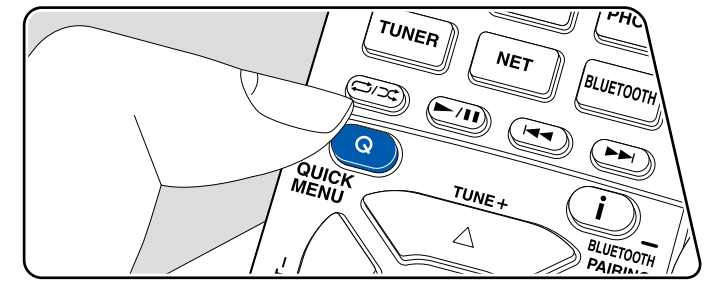
You can quickly adjust the settings you frequently use, such as tone adjustments, etc.
You can make the settings on the TV screen during playback. Press Q on the remote controller to display the Quick Menu.
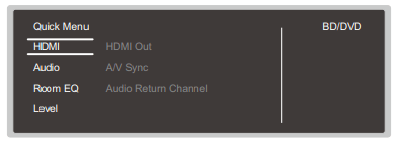
Select the item with the cursors  of the remote controller, and press the ENTER button to confirm your selection.
of the remote controller, and press the ENTER button to confirm your selection.
Use the cursors to change the settings.
- To return to the previous screen, press
 .
. - To exit the settings, press Q.
HDMI
HDMI Out: Select the HDMI OUT jack to output video signals from "MAIN", "SUB", and "MAIN+SUB".
A/V Sync: If the video is behind the audio, you can delay the audio to offset the gap. The setting can be set for each input.
- It cannot be set if the listening mode is Pure Audio or Direct.
Audio Return Channel: You can enjoy the sound of the HDMI-connected ARCcompatible TV through the speakers connected to the unit. Select "On" when listening to the audio of TV using the speakers of this unit. Select "Off" when the ARC function is not used.
Audio
Music Optimizer: Improve the quality of the compressed audio. Playback sound of lossy compressed files such as MP3 will be improved. The setting can be set for each input. This works in signals whose sampling frequencies are 48 kHz or less. The setting is not effective in the bitstream signals.
- It cannot be set if the listening mode is Pure Audio or Direct.
- This cannot be selected when either of the slots is selected with "Dirac Live" ( →p78).
Late Night: Enable small sounds to be easily heard in detail. It is useful when you need to reduce the volume while watching a movie late night.
- This function cannot be used in the following cases.
- When playing Dolby Digital Plus or Dolby TrueHD with "Loudness Management" set to "Off"
- When the input signal is DTS:X, and "Dialog Control" is not 0 dB
- When the input signal is Analog/DSD and the listening mode is Pure Audio or Direct
Stereo Assign: This function enables you to select a pair of speakers to output stereo sound. Apart from the front speakers (Front), you can select the Surround speakers (Surround), Surround Back speakers (Surround Back), Height 1 speakers (Height 1) and Height 2 speakers (Height 2).

- The listening mode switches to "Stereo" if the audio output destination is changed.
Zone B: Select a method of outputting audio to ZONE B from among "Off", "On (A+B)" and "On (B)".
In the following cases, "Zone B" cannot be selected.
- When ZONE 2 is On
- When "2. Speaker" - "Configuration" - "Zone 2 Lineout" on the Setup menu is set to "Zone 2". ( →p116)
Digital Filter: You can switch the type of digital filter in the AUDIO DAC (digital analog converter). You can choose "Slow" (gives the sound a soft and fluid feel), "Sharp" (gives the sound more structure and firmer feel) or "Auto" (auto). The setting can be separately set to each input selector. This can be set when the sampling frequency is 44.1 kHz or more.
Room EQ
Dirac Live (*1): You can select the equalizers measured with Dirac Live p144, p148) from "Slot1" to "Slot3". When disabling the equalizer, select
Off".
- The Dirac Live measurement results are saved in "Slot1" to "Slot3", but you are able to register your own original sound quality with "Manual Adjust" p149).
- This cannot be selected when measurements are made using "AccuEQ Room Calibration".
AccuEQ (*1)(*2): Enable or disable the equalizer function that corrects for sound distortion caused by the acoustic environment of the room.
On (All Ch): EQ that corrects according to the room acoustics acquired with the AccuEQ calibration is applied to all channels. On (ex. L/R): The same EQ as "On (All Ch)" is applied to speakers other than the Front Speakers. EQ correction for the Front Speakers is turned off.
- The setting can be separately set to each input selector.
Manual Equalizer (*1)(*2): Select "Preset 1" to "Preset 3" configured in "2. Speaker" - "Equalizer Settings" on the Setup menu. When this is set to "Off", the same sound field setting is applied to all ranges.
Re-EQ, Re-EQ(THX) (*1)(*2): Adjusts the soundtrack with the enhanced high range so that it suits a home theater.
The following listening modes can be used for Re-EQ: Dolby Audio - DD, Dolby Audio - DD+, Dolby Audio - Surr, Dolby Audio - TrueHD, Multichannel, DTS, DTS-ES, DTS 96/24, DTS-HD High Resolution Audio, DTS-HD Master Audio, DTS Neural:X, DTS Express and DSD
In Re-EQ(THX), the following listening modes can be used: THX Cinema and THX Select Cinema.
EQ for Standing Wave (*1)(*2): Setting this "On" will control the effect of the standing wave generated by the sound wave reflected by wall or similar interfering with the original sound wave.
(*1) It cannot be set if the listening mode is Pure Audio or Direct.
(*2) This function cannot be used if Dirac Live ( →p78) is being used. Furthermore, there is no effect even if it can be selected.
Level
Front: Adjust the speaker level of the front speakers while listening to the sound.
Center: Adjust the speaker level of the center speaker while listening to the sound.
Subwoofer: Adjust the speaker level of the subwoofer while listening to the sound.
- If you set the unit to the standby mode, the adjustments you made will be restored to the previous statuses.
Troubleshooting
Before starting the procedure
Problems may be solved by simply turning the power on/off or disconnecting/ connecting the power cord, which is easier than working on the connection, setting and operating procedure. Try the simple measures on both the unit and the connected device. If the problem is that the video or audio is not output or the HDMI linked operation does not work, disconnecting/connecting the HDMI cable may solve it. When reconnecting, be careful not to wind the HDMI cable since if wound the HDMI cable may not fit well. After reconnecting, turn off and on the unit and the connected device.
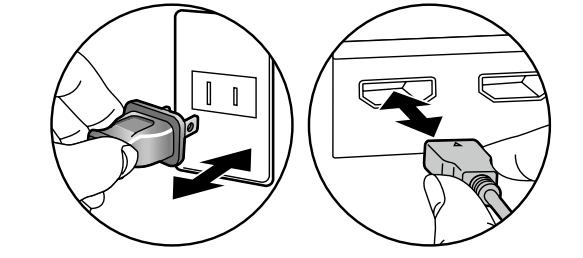
- The AV receiver contains a microPC for signal processing and control functions. In very rare situations, severe interference, noise from an external source, or static electricity may cause it to lockup. In the unlikely event that this happens, unplug the power cord from the wall outlet, wait at least 5 seconds, and then plug it back in.
- Our company is not responsible for damages (such as CD rental fees) due to unsuccessful recordings caused by the unit’s malfunction. Before you record important data, make sure that the material will be recorded correctly.
When the unit is operating erratically
 Try restarting the unit
Try restarting the unit
Restarting this unit may solve the problem. Set the main unit to standby, then after waiting for 5 seconds or more, press and hold the  ON/STANDBY button of the main unit for at least 5 seconds, and then restart the unit. (The settings on this unit are kept.) If the problem persists after restarting the unit, unplug and plug the power cords or HDMI cable of this unit and connected devices.
ON/STANDBY button of the main unit for at least 5 seconds, and then restart the unit. (The settings on this unit are kept.) If the problem persists after restarting the unit, unplug and plug the power cords or HDMI cable of this unit and connected devices.

 Resetting the unit (this resets the unit settings to the default)
Resetting the unit (this resets the unit settings to the default)
If the restart of the unit does not solve the problem, reset the unit, and restore all the settings to the factory default at the time of purchase. This may solve the problem. If the unit is reset, your settings are restored to the default values.
Be sure to note down your setting contents before performing the following operations. Note that it is not possible to reset the unit during the Initial Setup process. Before doing the following procedures, press to exit Initial Setup.
- While pressing and holding CBL/SAT of the input selector on the main unit with the unit turned on, press the ON/STANDBY button.
- Clear" is displayed on the display, and the unit returns to the standby state. Do not remove the power cord until "Clear" disappears from the display. To reset the remote controller, while pressing and holding MODE, press the CLEAR button at least 3 seconds.

Power
 When the power is turned on, "AMP Diag Mode" appears on the display of the main unit
When the power is turned on, "AMP Diag Mode" appears on the display of the main unit
- The protection circuit function may have operated. If the unit suddenly enters the standby state and "AMP Diag Mode" appears on the display of the main unit when the power is turned on again, this function is diagnosing whether or not the main unit is malfunctioning or there is an abnormality with the speaker cable connection. When the diagnosis is complete, the following messages are displayed.
 | If the unit returns to the normal ON state after "CH SP WIRE" appears on the display, the speaker cable may have been short-circuited. After setting the power of this unit to standby state, connect the speaker cable again. Twist the wires exposed from the tip of the speaker cable so that the wires do not stick out of the speaker terminal. |
 | If the operation has stopped with "NG" displayed on the display, set the power of this unit to standby state immediately and remove the power plug from the outlet. The unit may be malfunctioning. Consult a dealer. |
 The unit turns off unexpectedly
The unit turns off unexpectedly
- If "5. Hardware" - "Power Management" - "Auto Standby" on the Setup menu is activated, the unit automatically enters the standby mode.
- The protection circuit function may have operated due to an abnormal rise in temperature of the unit. In such a case, the power turns off repeatedly even if the power is turned on each time. Secure sufficient ventilation space around the unit, wait for a while until the temperature of the unit decreases. Then, turn the power on again.
WARNING: If smoke, smell or abnormal noise is produced by the unit, unplug the power cord from the outlet immediately, and contact the dealer or our company's support. p134)
Audio
- Make sure that the speaker setup microphone is no longer connected.
- Confirm that the connection between the output jack on the connected device and the input jack on this unit is correct.
- Make sure that none of the connecting cables are bent, twisted, or damaged.
- If "MUTING" is displayed on the display and is blinking, press on the remote controller to cancel muting.
- While headphones are connected to the PHONES jack, no sound is output from the speakers.
- When "4. Source" - "Audio Select" - "PCM Fixed Mode" on the Setup menu is set to "On", audio is not played if signals other than PCM are input. Change the setting to Off.
Check the following if the problem persists after you have confirmed the above.
 No sound from the TV
No sound from the TV
- Change the input selector on this unit to the position of the terminal to which the TV is connected.
- If the TV doesn't support the ARC function, along with connection by HDMI, connect the TV and this unit using a digital optical cable or analog audio cable. p49)
 No sound from a connected player
No sound from a connected player
- Change the input selector on this unit to the position of the jack to which the player is connected.
- Check the digital audio output setting on the connected device. On some game consoles, such as those supporting DVD, the default setting may be off.
- For some DVD-Video discs, you need to select an audio output format from a menu.
 A speaker produces no sound
A speaker produces no sound
- Make sure that the polarity (+/-) of the speaker cables is correct, and that no bare wires are in contact with the metal part of speaker terminals.
- Make sure that the speaker cables are not shorting out.
- Check "Connect the Speaker Cables" ( →p33) to see if the speaker connections have been made correctly. Settings for the speaker connection environment need to be made in "Speaker Setup" in Initial Setup. Check "Initial Setup with Auto Start-up Wizard" ( →p141).
- Depending on the input signal and listening mode, not much sound may be output from speakers. Select another listening mode to see if sound is output.
- If surround back speakers are installed, be sure to install surround speakers as well.
- A maximum of 7.1 ch playback is possible when Bi-Amping connection is used. Be sure to remove the jumper bar on the speakers when using Bi-Amping connection. p33)
 The subwoofer produces no sound
The subwoofer produces no sound
If the setting of the front speakers is "Full Band", the low range elements will be output from the front speakers instead of from the subwoofer during ch audio input of TV or music. To output the sound from the subwoofer, make one of the following settings.
- Change the setting for the front speakers to a setting of crossover frequency value other than "Full Band". The range below the specified frequency will be output from the subwoofer instead of from the front speakers. If your front speakers have a high low-range reproduction capability, changing this setting is not recommended.
- Change "Double Bass" to "On".
The low range elements of the front speakers will be output from both the front speakers and the subwoofer. Due to this, the bass sound may be emphasized too much. In such a case, do not change the setting, or make the setting with the above option 1.- For the setting details, refer to "2. Speaker" - "Crossover" on the Setup menu.
- If the input signals do not contain subwoofer audio elements (LFE), the subwoofer may produce no sound.
 Noise can be heard
Noise can be heard
- Using cable ties to bundle analog audio cables, power cords, speaker cables, etc. may degrade the audio performance. Do not bundle the cords.
- An audio cable may be picking up interference. Change the position of the cables.
 The beginning of audio received by an HDMI IN cannot be heard
The beginning of audio received by an HDMI IN cannot be heard
- Since it takes longer to identify the format of an HDMI signal than it does for other digital audio signals, audio output may not start immediately.
 Sound suddenly reduces
Sound suddenly reduces
- When using the unit for extended periods with the temperature inside the unit exceeding a certain temperature, the volume may be reduced automatically to protect the circuits.
 Sound suddenly changes
Sound suddenly changes
- When "My Input Volume" is set, the volume is set for each input selector. Check "4. Source" - "My Input Volume" on the Setup menu ( →p125).
Listening Modes
- To enjoy digital surround playback in formats such as Dolby Digital, you need to make a connection for audio signals with an HDMI cable, digital coaxial cable or digital optical cable. Also, audio output need to be set to Bitstream output on the connected Blu-ray Disc player, etc.
- Press i on the remote controller several times to switch the display of the main unit, and you can check the input format.
Check the following if the problem persists after you have confirmed the above.
 Cannot select a desired listening mode
Cannot select a desired listening mode
- Depending on the connection status of the speaker, some listening modes may not be selected. Check "Speaker Layouts and Selectable Listening Modes" ( →p166) or "Input Formats and Selectable Listening Modes" ( →p171).
 Cannot listen to the sound in Dolby TrueHD, Dolby Atmos or DTS-HD Master Audio format
Cannot listen to the sound in Dolby TrueHD, Dolby Atmos or DTS-HD Master Audio format
- If the audio in Dolby TrueHD, Dolby Atmos or DTS-HD Master Audio format cannot be output correctly in the source format, set "BD video supplementary sound" (or reencode, secondary sound, video additional audio, etc.) to "Off" in the setting of a connected Blu-ray Disc player, etc. After changing the setting, switch the listening mode to that for each source, and confirm.
 Cannot select Pure Audio mode
Cannot select Pure Audio mode
- The Pure Audio mode cannot be selected when the Multi-zone function is on.
 About Dolby signals
About Dolby signals
- When surround back speakers are included in the speaker layout, and software that is recorded with the 5.1-channel Dolby audio format is played, the surround channel audio may be output from the surround back speakers.
- Some Dolby Atmos audio format that is used on games, etc., may be recognized as "Multichannel PCM". If this occurs, check the firmware updates for the game console.
 About DTS signals
About DTS signals
- With media that switches suddenly from DTS to PCM, PCM playback may not start immediately. In such a case, stop playback on the player side for approx. 3 seconds or more. Then, resume playback. The playback will be performed normally.
- DTS playback may not be performed normally on some CD and LD players even if the player and this unit are digitally connected. If some processing (e.g., output level adjustment, sampling frequency conversion, or frequency characteristic conversion) has been executed for the DTS signal being output, this unit cannot recognize it as a genuine DTS signal, and noise may occur.
- While playing a DTS-compatible disc, if a pause or skip operation is performed on your player, noise may occur for a short period. This is not a malfunction.
Video
- Confirm that the connection between the output jack on the connected device and the input jack on this unit is correct.
- Make sure that none of the connecting cables are bent, twisted, or damaged.
- When the TV image is blurry or unclear, the power cord or connection cables of the unit may have interfered. In such a case, keep distance between TV antenna cable and cables of the unit.
- Check the switching of the input screen on the monitor side such as a TV.
Check the following if the problem persists after you have confirmed the above.
 No image appears
No image appears
- Change the input selector on this unit to the position of the jack to which the player is connected.
- While the Pure Audio listening mode is selected, only video signals input from the HDMI input jack can be output.
 No image from a device connected to HDMI IN jack
No image from a device connected to HDMI IN jack
- To display video from the connected player on the TV while the unit is in standby, you need to enable "5. Hardware" - "HDMI" - "HDMI Standby
- Through" on the Setup menu. For details of the HDMI Standby Through function, check "5. Hardware" - "HDMI" on the Setup menu.
- To output video to a TV connected to the HDMI OUT SUB jack, press the Q button on the remote controller to display "Quick Menu" and select "HDMI" - "HDMI Out", or press the HDMI MAIN/SUB button on the remote controller and select the HDMI OUT jack.
- Check if "Resolution Error" is displayed on the main unit display when video input via HDMI IN jack is not displayed. In this case, the TV does not support the resolution of the video input from the player. Change the setting on the player.
- Normal operation with an HDMI-DVI adapter is not guaranteed. In addition, video signals output from a PC are not guaranteed.
- Try switching off the Deep Color function. To turn off the Deep Color function, simultaneously press the STRM BOX and ON/STANDBY buttons on the main unit. While holding down STRM BOX, press ON/STANDBY repeatedly until "Deep Color:Off" appears on the display. To reactivate the Deep Color function, repeat the above described step until "Deep Color:On" is appeared on the display. p127)
 Images flicker
Images flicker
- The output resolution of the player may not be compatible with the resolution of the TV. If the player is connected to this unit with an HDMI cable, change the output resolution on the player. Also this may be solved by changing the screen mode on the TV.
 Video and audio are out of synch
Video and audio are out of synch
- Depending on the settings on your TV and connection environment, the video may be behind the audio. Press Q on the remote controller to display "Quick Menu", select "HDMI" - "A/V Sync", and make the adjustment. p77)
Linked operation
 HDMI linked operation does not work with CEC-compliant devices, such as a TV
HDMI linked operation does not work with CEC-compliant devices, such as a TV
- In the Setup menu of the unit, set "5. Hardware" - "HDMI" - "HDMI CEC" to "On".
- It is also necessary to set HDMI linking on the CEC-compliant device. Check the instruction manual.
- When connecting a Sharp brand player or recorder to the HDMI IN jacks, set "5. Hardware" - "HDMI" - "HDMI Standby Through" to "Auto" on the Setup menu.
Tuner
 Poor reception or much noise
Poor reception or much noise
- Recheck the antenna connection.
- Move the antenna away from the speaker cord or power cord.
- Move the unit away from your TV or PC.
- Passing cars or airplanes in the vicinity can cause interference.
- If radio waves are blocked by concrete walls, etc., radio reception may be poor.
- Change the reception mode to mono ( →p69).
- When listening to an AM station, operating the remote controller may cause noise. (North American, Australian and Asian models)
- FM reception may be clearer if you use the antenna jack on the wall used for the TV. p58)
 BLUETOOTH function
BLUETOOTH function
- Unplug and plug the power cord of the unit, or turn off and on the BLUETOOTH enabled device. Restart of the BLUETOOTH enabled device may be effective.
- BLUETOOTH enabled devices must support the A2DP profile.
- Because a radio wave interference will occur, this unit may not be used near devices such as a microwave oven or cordless phone which use the radio wave in the 2.4 GHz range.
- A metallic object near the unit can affect on the radio wave, and BLUETOOTH connection may not be possible.
Check the following if the problem persists after you have confirmed the above.
 Cannot transmit from a Bluetooth wireless technology enabled device (PC, smartphone, etc.) to this unit
Cannot transmit from a Bluetooth wireless technology enabled device (PC, smartphone, etc.) to this unit
- Check if the BLUETOOTH function of the BLUETOOTH enabled device is enabled.
 Cannot connect a BLUETOOTH wireless technology enabled device (PC, smartphone, etc.) to this unit
Cannot connect a BLUETOOTH wireless technology enabled device (PC, smartphone, etc.) to this unit
- Initialize the pairing information and perform pairing again.
Firstly delete all the pairing information saved on this unit. In the Setup menu, select "5. Hardware" - "Bluetooth" - "Bluetooth Receiver" - "PairingInformation", then press ENTER while "Clear" is displayed.
Next, delete the pairing information of this unit that is saved on the BLUETOOTH wireless technology enabled device. For information on how to clear the pairing information, refer to the BLUETOOTH enabled device's instruction manual.
Finally, perform pairing again. Refer to "Playing audio from BLUETOOTH wireless technology enabled devices with this unit" ( →p65) for pairing instructions.
 Cannot transmit from this unit to a Bluetooth wireless technology enabled device (wireless headphones, etc.)
Cannot transmit from this unit to a Bluetooth wireless technology enabled device (wireless headphones, etc.)
- Check that the "Bluetooth Transmitter" setting on this unit is set to either "On(Tx)" or "On(Main + Tx)". ( →p132)
 Cannot connect this unit to a BLUETOOTH wireless technology enabled device (wireless headphones, etc.)
Cannot connect this unit to a BLUETOOTH wireless technology enabled device (wireless headphones, etc.)
- Check if the BLUETOOTH function of the BLUETOOTH enabled device is enabled.
- Initialize the pairing information and perform pairing again.
Firstly delete all the pairing information saved on this unit. In the Setup menu, select "5. Hardware" - "Bluetooth" - "Bluetooth Transmitter" -Pairing Information", then press ENTER while "Clear" is displayed.
Next, delete the pairing information of this unit that is saved on the BLUETOOTH wireless technology enabled device. For information on how to clear the pairing information, refer to the BLUETOOTH enabled device's instruction manual.
Finally, perform pairing again. Refer to "Transmitting audio from this unit to BLUETOOTH wireless technology enabled devices" ( →p66) for pairing instructions. p133)
 Music playback is unavailable on the unit even after successful BLUETOOTH connection
Music playback is unavailable on the unit even after successful BLUETOOTH connection
- If the volume setting on this unit or the Bluetooth wireless technology enabled device is low, audio may not be played. Check the volume setting on this unit or the Bluetooth wireless technology enabled device.
- Some Bluetooth enabled devices may be equipped with a Send/Receive selector switch. Try switching the setting to suit the application the device is being used for.
- Depending on the characteristics or specifications of the BLUETOOTH enabled device, music may not be played back on this unit.
 Sound is interrupted
Sound is interrupted
- There maybe a problem with the BLUETOOTH enabled device. Check the information on a web page.
 The audio quality is poor after connection with a BLUETOOTH enabled device
The audio quality is poor after connection with a BLUETOOTH enabled device
- The BLUETOOTH reception is poor. Move the BLUETOOTH enabled device closer to the unit, or remove any obstacle between the BLUETOOTH enabled device and this unit.
Network function
- If you cannot select a network service, start up the network function to select it. It may take approx. one minute to start it up.
- When the NET indicator is blinking, this unit is not properly connected to the home network.
- Unplug and plug the power cords of this unit and the router, or restart the router.
- If the desired router is not displayed in the access point list, it may be set to hide SSID, or the ANY connection may be off. Change the setting and try again.
Check the following if the problem persists after you have confirmed the above.
 Cannot access the Internet radio
Cannot access the Internet radio
- In the case the service provider has terminated the service, the network service or contents may not be used on this unit.
- Check if your modem and router are properly connected, and they are both turned on.
- Check if the LAN side port on the router is properly connected to this unit.
- Check if connecting to Internet from other devices is possible. If it is not possible, turn off all devices connected to the network, wait for a while, and then turn on the devices again.
- Depending on ISP, setting the proxy server is required.
- Check if the router and modem you are using are supported by your ISP.
 Cannot access the network server
Cannot access the network server
- This unit needs to be connected to the same router as the network server.
- This unit supports the Windows Media® Player 12 network servers, or NASes that support the home network function.
- Windows Media® Player may require some settings. Refer to "Music Server".
- When using a PC, only the music files registered in the library of Windows Media Player can be played. (p100)
 Sound is interrupted when playing music files on the network server
Sound is interrupted when playing music files on the network server
- Check if the network server meets the requirements for operation.
- When the PC is serving as the network server, quit application software other than the server software (Windows Media® Player 12, etc.).
- If the PC is downloading or copying large files, the playback sound may be interrupted.
USB storage device
 USB storage device is not displayed
USB storage device is not displayed
- Check if the USB storage device or USB cable is securely inserted to the USB port of the unit.
- Disconnect the USB storage device once from the unit, and then reconnect it.
- Performance of the hard disk that receive power from the USB port of the unit is not guaranteed.
- Depending on the type of content, the playback may not be performed normally. Check the types of supported file formats.
- Operations of USB storage devices equipped with security functions are not guaranteed. p98)
Wireless LAN Network
Unplug and plug the power cords of this unit and the wireless LAN router, check the power-on status of the wireless LAN router, or restart the wireless LAN router.
Check the following if the problem persists after you have confirmed the above.
 Cannot access wireless LAN network
Cannot access wireless LAN network
- The wireless LAN router setting may be switched to Manual. Restore the setting to Auto.
- Try the manual set-up. The connection may succeed.
- When the wireless LAN router is in stealth mode (mode to hide SSID) or when the ANY connection is off, the SSID is not displayed. Change the setting and try again.
- Check if the SSID and encryption settings (WEP, etc.) are correct. Match the network settings with the settings of this unit.
- Connection to an SSID that includes multi-byte characters is not supported. Set the SSID of the wireless LAN router using single-byte alphanumeric characters only, and try again.
 Connected to an SSID different from the selected SSID
Connected to an SSID different from the selected SSID
- Some wireless LAN routers allow you to set multiple SSIDs for one unit. If connecting to such a router using the automatic setting button, you may end up connecting to an SSID different from the SSID you want to connect to. If this occurs, use the connection method requiring you to enter a password.
 Playback sound is interrupted, or communication is not possible
Playback sound is interrupted, or communication is not possible
- You may not receive radio waves due to poor radio wave conditions. Shorten the distance from the wireless LAN router, or remove obstacles to improve visibility, and connect again. Install the unit away from microwave ovens or other access points. It is recommended to install the wireless LAN router and the unit in the same room.
- If there is a metallic object near the unit, wireless LAN connection may not be possible because the metal affects the radio wave.
- When other wireless LAN devices are used near the unit, other symptoms may occur, such as interrupted playback and impossible communication. You can avoid those problems by changing the channel of your wireless LAN router. For instructions on changing channels, refer to the instruction manual supplied with your wireless LAN router.
- There may not be enough bandwidth available in wireless LAN. Use a wired LAN for connection.
ZONE B function
 Cannot output audio to ZONE B
Cannot output audio to ZONE B
- To output audio to ZONE B, set the audio output destination for "Audio" - "Zone B" on Quick menu to "On (A+B)" or "On (B)" and also set "2.Speaker" - "Configuration" - "Zone 2 Lineout" on the Setup menu to "Zone B". p105)
Multi-zone function
 Cannot ZONE-output the audio of externally connected AV components
Cannot ZONE-output the audio of externally connected AV components
- To output audio from an externally connected AV component to ZONE 2, connect it to any of HDMI IN1 to IN3 jacks. If the AV component is not equipped with an HDMI jack, use a digital coaxial cable, digital optical cable or analog audio cable. Also, the audio from externally connected AV components can be output to ZONE 2 only when the audio is analog or 2 ch PCM signal. When the AV component is connected to this unit with an HDMI cable, digital coaxial cable or digital optical cable, change the audio output of the AV component to the PCM output.
- When video and audio via HDMI input are output to ZONE 2, set "1. Input/Output Assign" - "TV Out / OSD" - "Zone 2 HDMI" ( →p111) to "Use" on the Setup menu.
- To output audio from an externally connected AV component to ZONE 3, use an analog audio cable for connection. Also, audio from externally connected AV components can be output to ZONE 3 only when it is an analog audio signal.
 Others
Others
- If the audio signal is from the NET input selector, the zone output is not possible for DSD audio signals.
Remote Controller
- Make sure that the batteries are inserted with the correct polarity.
- Insert new batteries. Do not mix different types of batteries, or old and new batteries.
- Make sure that the sensor of the main unit is not subjected to direct sunlight or inverter-type fluorescent lights. Relocate it if necessary.
- If the main unit is installed in a rack or cabinet with colored-glass doors, or if the doors are closed, the remote controller may not work normally.
Display
 The display does not light up
The display does not light up
- When the Dimmer function is working, the display may go dim. Press the DIMMER button, and change the brightness level of the display.
- The display is turned off when the Pure Audio listening mode is selected.
Others
 Strange noise can be heard from the unit
Strange noise can be heard from the unit
- If you have connected another device to the same outlet as this unit, strange noise may occur under the influence of the device. If the symptom is remedied by removing the power plug of the other device from the outlet, use different outlets for this unit and the device.
 The message "Noise Error" appears during AccuEQ Room Calibration
The message "Noise Error" appears during AccuEQ Room Calibration
- This can be caused by a malfunction in your speaker unit. Check the speaker output, etc.
 The measurement results of AccuEQ Room Calibration show different distances to the speakers from the actual ones
The measurement results of AccuEQ Room Calibration show different distances to the speakers from the actual ones
- Depending on the speakers you are using, some errors may occur in the measurement results. If this is the case, make the settings in "2.Speaker" - "Distance" in the Setup menu. p118)
 The measurement results of AccuEQ Room Calibration show that the volume level of the subwoofer has been corrected to the lower limit
The measurement results of AccuEQ Room Calibration show that the volume level of the subwoofer has been corrected to the lower limit
- The volume level correction of the subwoofer may not have been completed. Lower the volume of the subwoofer before AccuEQ Room Calibration measurement.
 The settings in "Crossover", "Distance", and "Channel Level" are returned to the default values
The settings in "Crossover", "Distance", and "Channel Level" are returned to the default values
- When measurements are made with Dirac Live, if you change the settings in "Speaker Channels", "Subwoofer", "Height 1 Speaker", or "Height Speaker" in "2.Speaker" - "Configuration" ( →p115) in the Setup menu, then the measurement results are returned to the default values. Measure again.
See other models: TX-NR6100 TX-NR5100 TX-NR585 CS-265 ES-FC300W
